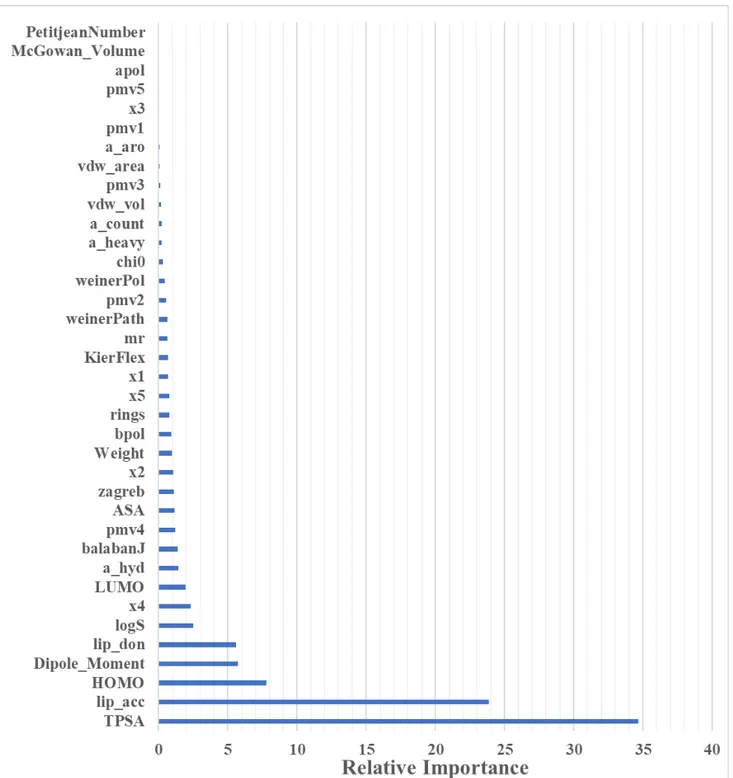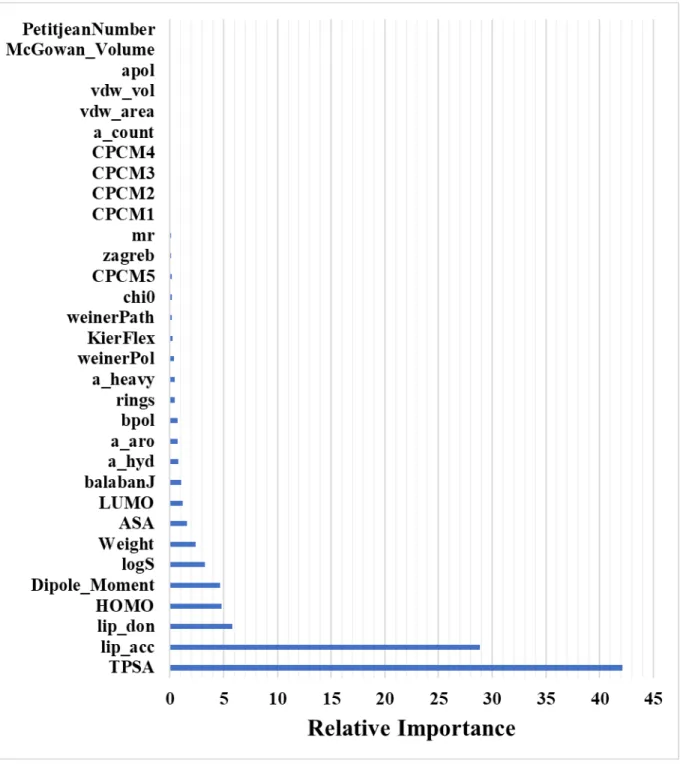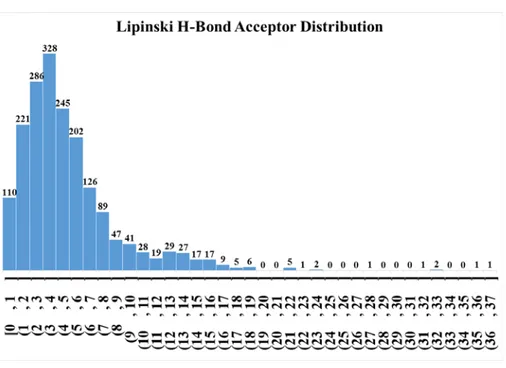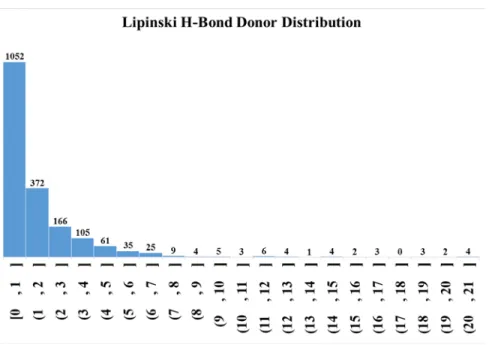S1
Supporting Information for
To Pass or Not To Pass: Predicting the Blood-Brain
Barrier Permeability with the 3D-RISM-KH
Molecular Solvation Theory
Dipankar Roy,1 Vijaya Kumar Hinge, 1 Andriy Kovalenko1,2,*
1 Department of Mechanical Engineering, University of Alberta, 10-203 Donadeo Innovation Centre for Engineering, 9211-116 Street NW, Edmonton, Alberta T6G 1H9, Canada
2 Nanotechnology Research Centre, 11421 Saskatchewan Drive, Edmonton, Alberta T6G 2M9, Canada
S2
Descriptors used for Model A:
Descriptor Details Descriptor Details
TPSA Topological Polar Surface
Area KierFlex Molecular flexibility index
lip_acc Lipinski H-bond acceptor
count mr Molar refractivity
HOMO Highest occupied molecular
orbital weinerPath weiner path number
Dipole_Moment Dipole Moment pmv2 Partial molar volume in
cyclohexane
lip_don Lipinski H-bond donor
count weinerPol weiner polarity number
logS aqueous solubility
descriptor chi0 connectivity descriptor
x4 Excess chemical potential
in n-octanol a_heavy Total number of heavy atoms
LUMO Lowest unoccupied
molecular orbital a_count Total number of atoms
a_hyd Number of hydrogen atoms vdw_vol van der Wall's volume
balabanJ Balaban's J Index pmv3 Partial molar volume in
n-hexadecane
pmv4 Partial molar volume in
n-octanol vdw_area van der Wall's area
ASA Accessible surface area a_aro Total number of aromatic
atoms
zagreb Zagreb index pmv1 Partial molar volume in
chloroform
x2 Excess chemical potential
in cyclohexane x3
Excess chemical potential in n-hexadecane
Weight Molecular weight pmv5 Partial molar volume in water
bpol
Sum of the absolute value of the difference between atomic polarizabilities of all
bonded atoms in the molecule (including implicit hydrogens)
Apol
Sum of the atomic polarizabilities (including
implicit hydrogens)
rings ring count McGowan_Volume Characteristic McGowan
volume
x5 Excess chemical potential
in n-hexadecane PetitjeanNumber Petitjean Number
x1 Excess chemical potential
S3
Figure S1: Relative importance (influence) of different variables in Model A obtained from
S4
Descriptors used for Model B:
Descriptor Details Descriptor Details
TPSA Topological Polar Surface
Area x4
Excess chemical potential in n-octanol
lip_acc Lipinski H-bond acceptor
count pmv4
Partial molar volume in n-octanol
HOMO Highest occupied molecular
orbital x2
Excess chemical potential in cyclohexane
Dipole_Moment Dipole Moment Weight Molecular weight
lip_don Lipinski H-bond donor
count chi0 connectivity descriptor
logS aqueous solubility
descriptor
Figure S2: Relative importance (influence) of different variables in Model B obtained from
S5
Descriptors used for Model C:
Descriptor Details Descriptor Details
TPSA Topological Polar Surface
Area KierFlex Molecular flexibility index
lip_acc Lipinski H-bond acceptor
count x2
Excess chemical potential in cyclohexane
HOMO Highest occupied molecular
orbital balabanJ Balaban's J Index
Dipole_Moment Dipole Moment x4 Excess chemical potential in
n-octanol
lip_don Lipinski H-bond donor
count LUMO
Lowest unoccupied molecular orbital
GapHL HOMO-LUMO energy gap
(in ev)
Figure S3: Relative importance (influence) of different variables in Model C obtained from
S6
Descriptors used for Model D:
Descriptor Details Descriptor Details
TPSA Topological Polar Surface
Area x4
Excess chemical potential in n-octanol
lip_acc Lipinski H-bond acceptor
count pmv4
Partial molar volume in n-octanol
HOMO Highest occupied molecular
orbital x2
Excess chemical potential in cyclohexane
Dipole_Moment Dipole Moment lip_don Lipinski H-bond donor count
Figure S4: Relative importance (influence) of different variables in Model D obtained from
S7
Descriptors used for Model E:
Descriptor Details
TPSA Topological Polar Surface Area
lip_acc Lipinski H-bond acceptor count
HOMO Highest occupied molecular orbital
Dipole_Moment Dipole Moment
x4 Excess chemical potential in n-octanol
Figure S5: Relative importance (influence) of different variables in Model E obtained from
S8
Descriptors used for building model with CPCM calculated solvation energy:
Descriptor Details Descriptor Details
TPSA Topological Polar Surface
Area KierFlex Molecular flexibility index
lip_acc Lipinski H-bond acceptor
count mr Molar refractivity
HOMO Highest occupied molecular
orbital weinerPath weiner path number
Dipole_Moment Dipole Moment
lip_don Lipinski H-bond donor
count weinerPol weiner polarity number
logS aqueous solubility
descriptor chi0 connectivity descriptor
LUMO Lowest unoccupied
molecular orbital a_heavy Total number of heavy atoms
a_hyd Number of hydrogen atoms CPCM1 ΔΔGChloroform
balabanJ Balaban's J Index CPCM2 ΔΔGCyclohexane
ASA Accessible surface area CPCM3 ΔΔGn-Hexadecane
Zagreb Zagreb index CPCM4 ΔΔGn-octanol
CPCM5 ΔΔGWater
Weight Molecular weight vdw_area van der Wall's area
Bpol
Sum of the absolute value of the difference between atomic polarizabilities of all
bonded atoms in the molecule (including implicit hydrogens)
vdw_vol van der Wall's volume
Rings ring count a_aro Total number of aromatic
atoms
Apol
Sum of the atomic polarizabilities (including
implicit hydrogens)
a_count Total number of atoms
PetitjeanNumber Petitjean Number McGowan_Volume Characteristic McGowan
S9
Figure S6: Relative importance (influence) of different variables in of model, built using CPCM
S10
Descriptors used for building model with SMD calculated solvation energy:
Descriptor Details Descriptor Details
TPSA Topological Polar Surface
Area KierFlex Molecular flexibility index
lip_acc Lipinski H-bond acceptor
count mr Molar refractivity
HOMO Highest occupied molecular
orbital weinerPath weiner path number
Dipole_Moment Dipole Moment
lip_don Lipinski H-bond donor
count weinerPol weiner polarity number
logS aqueous solubility
descriptor chi0 connectivity descriptor
LUMO Lowest unoccupied
molecular orbital a_heavy Total number of heavy atoms
a_hyd Number of hydrogen atoms SMD1 ΔΔGChloroform
balabanJ Balaban's J Index SMD2 ΔΔGCyclohexane
ASA Accessible surface area SMD3 ΔΔGn-Hexadecane
Zagreb Zagreb index SMD4 ΔΔGn-octanol
SMD5 ΔΔGWater
Weight Molecular weight vdw_area van der Wall's area
Bpol
Sum of the absolute value of the difference between atomic polarizabilities of all
bonded atoms in the molecule (including implicit hydrogens)
vdw_vol van der Wall's volume
Rings ring count a_aro Total number of aromatic
atoms
Apol
Sum of the atomic polarizabilities (including
implicit hydrogens)
a_count Total number of atoms
PetitjeanNumber Petitjean Number McGowan_Volume Characteristic McGowan
S11
Figure S7: Relative importance (influence) of different variables of model, built using SMD
S12
Descriptors used for building model without 3D-RISM-KH calculated solvation descriptors:
Descriptor Details Descriptor Details
TPSA Topological Polar Surface
Area ASA Accessible surface area
lip_acc Lipinski H-bond acceptor
count Rings Number of rings
HOMO Highest occupied molecular
orbital lip_don Lipinski H-bond donor count
Dipole_Moment Dipole Moment logS aqueous solubility descriptor
Figure S8: Relative importance (influence) of different variables in model, built without using
S13
Figure S9: Molecular weight distribution of the entire dataset (bin width 50).
S14
Figure S11: Lipinski donor distribution of the entire dataset (bin width 1).
S15
Figure S13: Heavy atom count distribution of the entire dataset (bin width 3).
S16
Figure S15: %-Distribution of blood-brain permeability in the training and test sets.
Table S1: Performance of logP(octanol-water) based prediction schemes with 7-variables in
classification models using the SVM techniquea
logP Prediction Method Accuracy Precision Sensitivity Specificity F1-Score
ALogP 0.95 0.96 0.98 0.85 0.96
CrippenLogP 0.96 0.96 0.98 0.87 0.97
ManholandLogP 0.96 0.96 0.98 0.88 0.97
XLogP 0.96 0.96 0.99 0.88 0.98
aFor a measure of percentage of accuracy indices, please multiply individual values by 100%.
Please see the footnote in Table 1 for the definitions of performance indices used. Descriptors used for these calculations are HOMO, Dipole moment, molecular connectivity index, Lipinski H-bond donor, Lipinski H-bond acceptor, TPSA, and logP.
S17
Full Citation of Reference 36:
Frisch, M. J.; Trucks, G. W.; Schlegel, H. B.; Scuseria, G. E.; Robb, M. A.; Cheeseman, J. R.; Scalmani, G.; Barone, V.; Petersson, G. A.; Nakatsuji, H.; Li, X.; Caricato, M.; Marenich, A. V.; Bloino, J.; Janesko, B. G.; Gomperts, R.; Mennucci, B.; Hratchian, H. P.; Ortiz, J. V.; Izmaylov, A. F.; Sonnenberg, J. L.; Williams; ; Ding, F.; Lipparini, F.; Egidi, F.; Goings, J.; Peng, B.; Petrone, A.; Henderson, T.; Ranasinghe, D.; Zakrzewski, V. G.; Gao, J.; Rega, N.; Zheng, G.; Liang, W.; Hada, M.; Ehara, M.; Toyota, K.; Fukuda, R.; Hasegawa, J.; Ishida, M.; Nakajima, T.; Honda, Y.; Kitao, O.; Nakai, H.; Vreven, T.; Throssell, K.; Montgomery, J. A., Jr.; Peralta, J. E.; Ogliaro, F.; Bearpark, M. J.; Heyd, J. J.; Brothers, E. N.; Kudin, K. N.; Staroverov, V. N.; Keith, T. A.; Kobayashi, R.; Normand, J.; Raghavachari, K.; Rendell, A. P.; Burant, J. C.; Iyengar, S. S.; Tomasi, J.; Cossi, M.; Millam, J. M.; Klene, M.; Adamo, C.; Cammi, R.; Ochterski, J. W.; Martin, R. L.; Morokuma, K.; Farkas, O.; Foresman, J. B.; Fox, D. J. et al. Gaussian16, revision B.01; Gaussian Inc.: Wallingford, CT, 2016.
Complete Citation for Reference 39:
Case, D. A.; Ben-Shalom, I. Y.; Brozell, S. R.; Cerutti, D. S.; Cheatham, T. E., III.; Cruzeiro, V. W. D.; Darden, T. A.; Duke, R. E.; Ghoreishi, D.; Gilson, M. K., et al.; Gohlke, H.; Goetz, A. W.; Greene, D.; Harris, R.; Homeyer, N.; Izadi, S.; Kovalenko, A.; Kurtzman, T.; Lee, T. S.; LeGrand, S.; Li, P.; Lin, C.; Liu, J.; Luchko, T.; Luo, R.; Mermelstein, D. J.; Merz, K. M.; Miao, Y.; Monard, G.; Nguyen, C.; Nguyen, H.; Omelyan, I.; Onufriev, A.; Pan, F.; Qi, R.; Roe, D. R.; Roitberg, A.; Sagui, C.; Schott-Verdugo, S.; Shen, J.; Simmerling, C. L.; Smith, J.; Salomon-Ferrer, R.; Swails, J.; Walker, R. C.; Wang, J.; Wei, H.; Wolf, R. M.; Wu, X.; Xiao, L.; York, D. M.; Kollman, P. A. AMBER; University of California: San Francisco, 2018.









